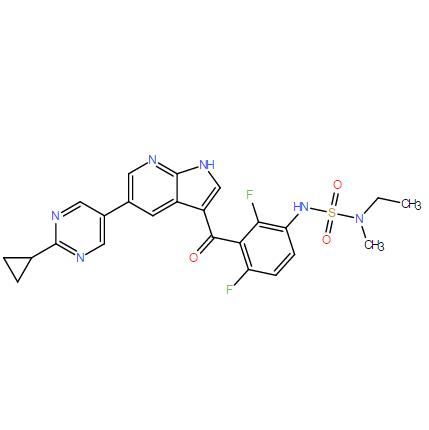| Description: |
PLX7904 is a potent and selective BRAF inhibitor, with IC50 of appr 5 nM against BRAFV600E in mutant RAS expressing cells. |
| Target: |
BRafV600E:5 nM (IC50, in mutant RAS expressing cells) |
| In Vitro: |
PLX7904 inhibits the in vitro growth of two melanoma cell lines (A375 and COLO829) and an additional human colorectal cancer cell line COLO205 that expresses BRAFV600E with IC50 values of 0.17 μM, 0.53 μM, and 0.16 μM, respectively, on a par with vemurafenib IC50 values in the same assays (0.33 μM, 0.69 μM, and 0.25 μM, respectively)[1]. PLX7904 and PLX8394 potently inhibit ERK1/2-driven GAL4-Elk1 reporter activity in PRT cells as well as parental cells. PLX7904 and PLX8394 treatment at 1 μM concentration reduce colony formation and viability in parental cells to a similar level as PLX4720[2]. PPLX7904 potently inhibits phosphorylation of ERK1/2 in mutant BRAF melanoma cells without eliciting paradoxical activation in wild-type BRAF, mutant NRAS melanoma cells. PPLX7904 inhibits ERK1/2 in PLX470-resistant cell lines. PPLX7904 treatment promotes apoptosis and inhibits anchorage-independent growth of vemurafenib resistant cells[3]. |
| Cell Assay: |
For MTT assays, 2×103 cells are seeded in triplicate in 96 wells in their regular culture medium (containing PLX4720 for PRT lines). Next day, cells are washed twice with PBS and then the medium is replenished containing the indicated RAF inhibitor. Medium is changed 48 hours later and after a further 48 hours, 10 μL of 5 mg/mL MTT reagent is added to wells, and incubated for three hours. Formazan crystals are then solubilized overnight with a 1:10 dilution of 0.1 M glycine (pH 10.5) in DMSO. Wells are then analyzed at 450 nM in a Multiskan® Spectrum spectrophotometer. Results depicted are normalized to DMSO conditions and are a composite of three independent experiments. Error bars shown are representative of the standard error of mean (SEM). |
| Animal Administration: |
COLO205 tumour cells are cultured in DMEM 10% FBS 1% penicillin/streptomycin supplemented with bovine insulin, at 37°C. Balb/C nude mice, female, 6-8 weeks old, weighing approximately 18-22 g, are inoculated subcutaneously at the right flank with COLO205 tumour cells (5×106) in 0.1 mL of PBS mixed with matrigel (50:50) for tumour development. The treatment is started when mean tumour size reach approximately 100 mm3, with eight mice in each treatment group randomized to balance the average weight and tumour size. B9 cells are expanded in DMEM 10% FBS 1% penicillin/streptomycin. Upon trypsinization the cells are washed three times with 20 mL RPMI, and after the final centrifugation are re-suspended, counted, and adjusted by volume to a final concentration of 5×107 cells per millilitre. B9 xenografts are started by injection of 5×106 cells subcutaneously in 6- to 7-week-old female nude Balb/c mice. Compound dosing starts when the average size of tumours reach 50-70 mm3. Animals are equally distributed over treatment groups (n=10) to balance the average tumour size and body weight. Animals are dosed orally for days 1-14 twice daily and days 15-28 once daily with vehicle, vemurafenib 50 mg per kg, or PLX7904 50 mg per kg. 12-O-tetradecanoylphorbol-13-acetate (TPA) is put on the skin of all mice twice a week during weeks 3 and 4 at a dose of 2 µg in 200 µL acetone. |
| References: |
[1]. Zhang C, et al. RAF inhibitors that evade paradoxical MAPK pathway activation. Nature. 2015 Oct 22;526(7574):583-586.
[2]. Basile KJ, et al. Inhibition of mutant BRAF splice variant signaling by next-generation, selective RAF inhibitors. Pigment Cell Melanoma Res. 2014 May;27(3):479-84
[3]. Le K, et al. Selective RAF inhibitor impairs ERK1/2 phosphorylation and growth in mutant NRAS, vemurafenib-resistant melanoma cells. Pigment Cell Melanoma Res. 2013 Jul;26(4):509-17 |






















